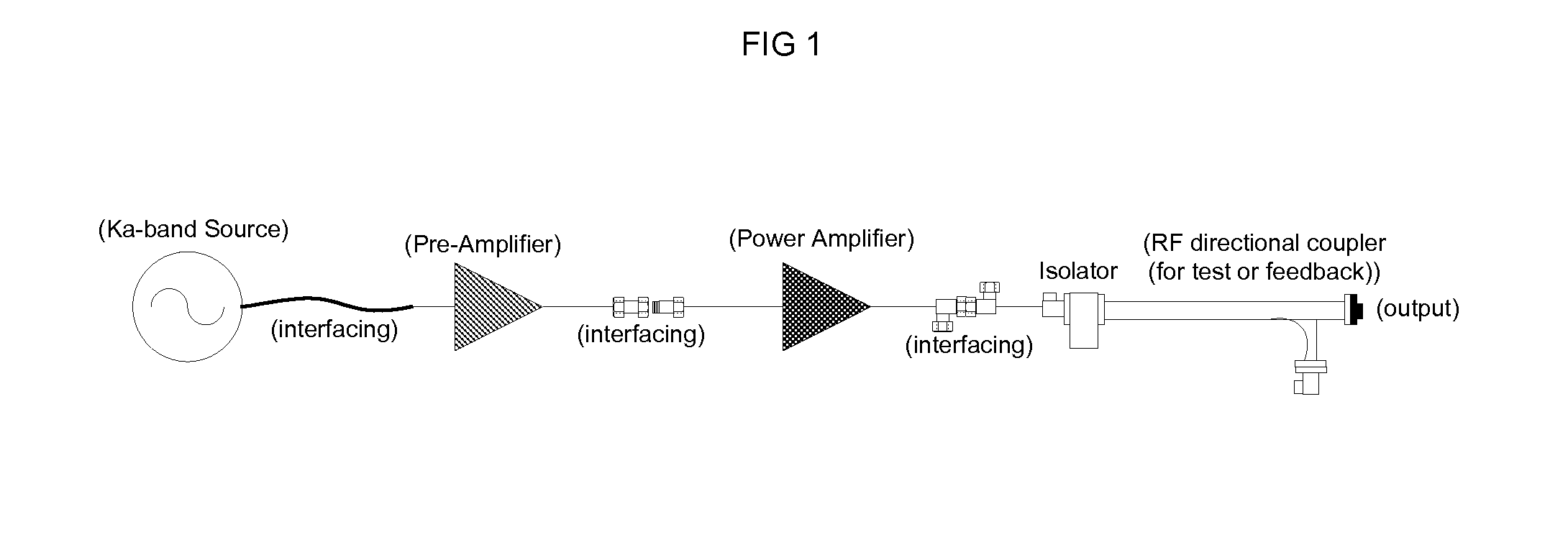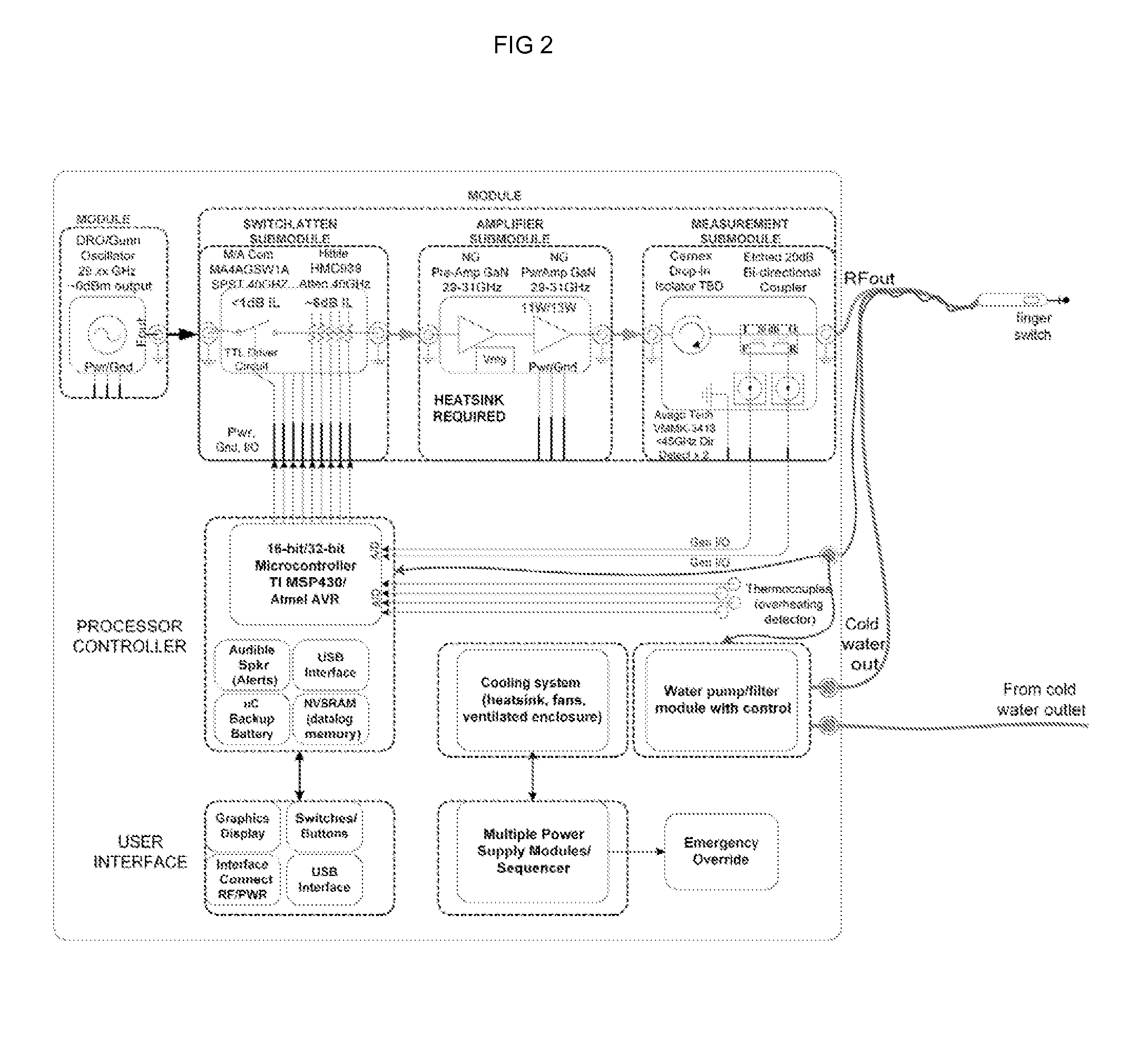Method and device for treating caries using locally delivered microwave energy
a microwave energy and caries technology, applied in the field of dentistry, can solve the problems of tooth loss, tooth loss, tooth loss, and progressive destruction of tooth structure, and achieve the effects of reducing the risk of tooth loss, and improving the quality of li
- Summary
- Abstract
- Description
- Claims
- Application Information
AI Technical Summary
Benefits of technology
Problems solved by technology
Method used
Image
Examples
example 1
Microwave Device
[0031]A microwave system (FIGS. 1, 2), which in certain embodiments is portable, includes a control system operating in a range of −5 to +5 volts, a signal generator operating in the range of −5 to 29 volts, an amplification system operating n the range of −5 to 30 volts, and which in certain embodiments contains a Gallium Nitride (GaN) based amplifier operating in the range of Ka band range of 26.5 GHz to 40 GHz, and in certain embodiments in the range of 28 to 32 GHz, a feedback sub system to monitor forward and reflected power, and a delivery system for the microwave energy includes waveguide coupler, a waveguide or a coaxial cable and an antenna was designed and built. Multiple issues were considered in the design which included portability, the ability to deliver focused microwaves at useful frequencies, power output, antenna design, attenuation issues, signal, impedance matching and others. A discussion on the resolution of these design issues is beyond the sco...
example 2
Bacterial Studies
[0032]Initial studies were undertaken to evaluate the variables involved in obtaining kill rates of Streptococcus mutans, the latter being the major pathogen in caries proliferation. The variables included frequency selection, antenna design, power output and time to obtain effective kill rates. Studies were initially conducted using direct microwave exposure of bacteria in microfuge tubes at various times to select out appropriate exposure parameters. Using these parameters, the studies were repeated in a tooth model where a bacteria-containing microfuge tube was placed internally to a depth of 4 mm. For these studies, the microwave antenna was brought into contact with side of the tooth, and the bacteria were radiated for various times, up to 90 seconds. Direct exposure of bacteria to Ka band microwaves in media produced kill rates that approached 100% at relatively short periods of time (20 seconds.) Kill rates using the microfuge embedded in a tooth ranged from ...
example 3
Thermal Effect of Microwaves on Teeth
[0035]The rate at which the microwave energy is absorbed by teeth is dependent upon their microwave parameters. These include the real and the imaginary part of the complex dielectric constant as given by Eqn. 1:
ε▴=ε′+j ε″=ε′+j·σ(ω) / ω (Eqn. 1),
[0036]where ε′ is the real part of the dielectric constant
[0037]ε″ is the imaginary part of the dielectric constant
[0038]j is the conductivity, and
[0039]ω is the operating frequency (radians)
[0040]As this energy is absorbed, it is thermally conducted into the tooth at a rate determined by its thermal conductivity. Thus the heating profile is dependent upon the microwave parameters, the thermal conductor parameters, the rate at which the microwave energy is deposited into the material, the operating frequency, and the impedance match between the antenna and the material. Theoretical calculations for these variables are shown in Table 1 above (note that 2 data points for conductivity for dentin are unavailab...
PUM
 Login to View More
Login to View More Abstract
Description
Claims
Application Information
 Login to View More
Login to View More - R&D
- Intellectual Property
- Life Sciences
- Materials
- Tech Scout
- Unparalleled Data Quality
- Higher Quality Content
- 60% Fewer Hallucinations
Browse by: Latest US Patents, China's latest patents, Technical Efficacy Thesaurus, Application Domain, Technology Topic, Popular Technical Reports.
© 2025 PatSnap. All rights reserved.Legal|Privacy policy|Modern Slavery Act Transparency Statement|Sitemap|About US| Contact US: help@patsnap.com



